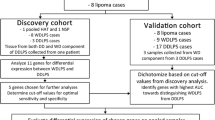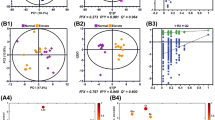Abstract
Retroperitoneal liposarcoma (RLPS) is the main subtype of retroperitoneal soft sarcoma (RSTS) and has a poor prognosis and few treatment options, except for surgery. The proteomic and metabolic profiles of RLPS have remained unclear. The aim of our study was to reveal the metabolic profile of RLPS. Here, we performed proteomic analysis (n = 10), metabolomic analysis (n = 51), and lipidomic analysis (n = 50) of retroperitoneal dedifferentiated liposarcoma (RDDLPS) and retroperitoneal well-differentiated liposarcoma (RWDLPS) tissue and paired adjacent adipose tissue obtained during surgery. Data analysis mainly revealed that glycolysis, purine metabolism, pyrimidine metabolism and phospholipid formation were upregulated in both RDDLPS and RWDLPS tissue compared with the adjacent adipose tissue, whereas the tricarboxylic acid (TCA) cycle, lipid absorption and synthesis, fatty acid degradation and biosynthesis, as well as glycine, serine, and threonine metabolism were downregulated. Of particular importance, the glycolytic inhibitor 2-deoxy-D-glucose and pentose phosphate pathway (PPP) inhibitor RRX-001 significantly promoted the antitumor effects of the MDM2 inhibitor RG7112 and CDK4 inhibitor abemaciclib. Our study not only describes the metabolic profiles of RDDLPS and RWDLPS, but also offers potential therapeutic targets and strategies for RLPS.
Similar content being viewed by others
References
Barry FP, Murphy JM. Mesenchymal stem cells: clinical applications and biological characterization. Int J Biochem Cell Biol 2004; 36(4): 568–584
Improta L, Tzanis D, Bouhadiba T, Abdelhafidh K, Bonvalot S. Overview of primary adult retroperitoneal tumours. Eur J Surg Oncol 2020; 46(9): 1573–1579
Carbone F, Pizzolorusso A, Di Lorenzo G, Di Marzo M, Cannella L, Barretta ML, Delrio P, Tafuto S. Multidisciplinary management of retroperitoneal sarcoma: diagnosis, prognostic factors and treatment. Cancers (Basel) 2021; 13(16): 4016
Pedeutour F, Forus A, Coindre JM, Berner JM, Nicolo G, Michiels JF, Terrier P, Ranchere-Vince D, Collin F, Myklebost O, Turc-Carel C. Structure of the supernumerary ring and giant rod chromosomes in adipose tissue tumors. Genes Chromosomes Cancer 1999; 24(1): 30–41
Lu J, Wood D, Ingley E, Koks S, Wong D. Update on genomic and molecular landscapes of well-differentiated liposarcoma and dedifferentiated liposarcoma. Mol Biol Rep 2021; 48(4): 3637–3647
Eisenberg L, Eisenberg-Bord M, Eisenberg-Lerner A, Sagi-Eisenberg R. Metabolic alterations in the tumor microenvironment and their role in oncogenesis. Cancer Lett 2020; 484: 65–71
Coutzac C, Jouniaux JM, Paci A, Schmidt J, Mallardo D, Seck A, Asvatourian V, Cassard L, Saulnier P, Lacroix L, Woerther PL, Vozy A, Naigeon M, Nebot-Bral L, Desbois M, Simeone E, Mateus C, Boselli L, Grivel J, Soularue E, Lepage P, Carbonnel F, Ascierto PA, Robert C, Chaput N. Systemic short chain fatty acids limit antitumor effect of CTLA-4 blockade in hosts with cancer. Nat Commun 2020; 11(1): 2168
Hay N. Reprogramming glucose metabolism in cancer: can it be exploited for cancer therapy? Nat Rev Cancer 2016; 16(10): 635–649
Pinho SS, Reis CA. Glycosylation in cancer: mechanisms and clinical implications. Nat Rev Cancer 2015; 15(9): 540–555
RodrÍguez E, Schetters STT, van Kooyk Y. The tumour glycocode as a novel immune checkpoint for immunotherapy. Nat Rev Immunol 2018; 18(3): 204–211
DeBerardinis RJ, Chandel NS. We need to talk about the Warburg effect. Nat Metab 2020; 2(2): 127–129
Vasan K, Werner M, Chandel NS. Mitochondrial metabolism as a target for cancer therapy. Nat Metab 2020; 32(3): 341–352
Fan J, Ye J, Kamphorst JJ, Shlomi T, Thompson CB, Rabinowitz JD. Quantitative flux analysis reveals folate-dependent NADPH production. Nature 2014; 510(7504): 298–302
Nogueira V, Hay N. Molecular pathways: reactive oxygen species homeostasis in cancer cells and implications for cancer therapy. Clin Cancer Res 2013; 19(16): 4309–4314
Joyce JA, Fearon DT. T cell exclusion, immune privilege, and the tumor microenvironment. Science 2015; 348(6230): 74–80
Li F, Simon MC. Cancer cells don’t live alone: metabolic communication within tumor microenvironments. Dev Cell 2020; 54(2): 183–195
Doherty JR, Cleveland JL. Targeting lactate metabolism for cancer therapeutics. J Clin Invest 2013; 123(9): 3685–3692
Hui S, Ghergurovich JM, Morscher RJ, Jang C, Teng X, Lu W, Esparza LA, Reya T, Le Zhan, Yanxiang Guo J, White E, Rabinowitz JD. Glucose feeds the TCA cycle via circulating lactate. Nature 2017; 551(7678): 115–118
Watson MJ, Vignali PDA, Mullett SJ, Overacre-Delgoffe AE, Peralta RM, Grebinoski S, Menk AV, Rittenhouse NL, DePeaux K, Whetstone RD, Vignali DAA, Hand TW, Poholek AC, Morrison BM, Rothstein JD, Wendell SG, Delgoffe GM. Metabolic support of tumour-infiltrating regulatory T cells by lactic acid. Nature 2021; 591(7851): 645–651
Jo SH, Son MK, Koh HJ, Lee SM, Song IH, Kim YO, Lee YS, Jeong KS, Kim WB, Park JW, Song BJ, Huhe TL. Control of mitochondrial redox balance and cellular defense against oxidative damage by mitochondrial NADP+-dependent isocitrate dehydrogenase. J Biol Chem 2001; 276(19): 16168–16176
Hishikawa D, Hashidate T, Shimizu T, Shindou H. Diversity and function of membrane glycerophospholipids generated by the remodeling pathway in mammalian cells. J Lipid Res 2014; 55(5): 799–807
Lingwood D, Simons K. Lipid rafts as a membrane-organizing principle. Science 2010; 327(5961): 46–50
Mullen PJ, Yu R, Longo J, Archer MC, Penn LZ. The interplay between cell signalling and the mevalonate pathway in cancer. Nat Rev Cancer 2016; 16(11): 718–731
Sehdev A, Shih YC, Huo D, Vekhter B, Lyttle C, Polite B. The role of statins for primary prevention in non-elderly colorectal cancer patients. Anticancer Res 2014; 34(9): 5043–5050
Yang WS, Stockwell BR. Ferroptosis: death by lipid peroxidation. Trends Cell Biol 2016; 26(3): 165–176
Dixon SJ, Winter GE, Musavi LS, Lee ED, Snijder B, Rebsamen M, Superti-Furga G, Stockwell BR. Human haploid cell genetics reveals roles for lipid metabolism genes in nonapoptotic cell death. ACS Chem Biol 2015; 10(7): 1604–1609
Wang B, Tontonoz P. Phospholipid remodeling in physiology and disease. Annu Rev Physiol 2019; 81(1): 165–188
Chamberlain F, Benson C, Thway K, Huang P, Jones RL, Gennatas S. Pharmacotherapy for liposarcoma: current and emerging synthetic treatments. Future Oncol 2021; 17(20): 2659–2670
Zhu Z, Jiang W, McGinley JN, Thompson HJ. 2-Deoxyglucose as an energy restriction mimetic agent: effects on mammary carcinogenesis and on mammary tumor cell growth in vitro. Cancer Res 2005; 65(15): 7023–7030
Raez LE, Papadopoulos K, Ricart AD, Chiorean EG, Dipaola RS, Stein MN, Rocha Lima CM, Schlesselman JJ, Tolba K, Langmuir VK, Kroll S, Jung DT, Kurtoglu M, Rosenblatt J, Lampidis TJ. A phase I dose-escalation trial of 2-deoxy-D-glucose alone or combined with docetaxel in patients with advanced solid tumors. Cancer Chemother Pharmacol 2013; 71(2): 523–530
Cabrales P. RRx-001 acts as a dual small molecule checkpoint inhibitor by downregulating CD47 on cancer cells and SIRP-alpha on monocytes/macrophages. Transl Oncol 2019; 12(4): 626–632
Acknowledgements
We thank Haiping Zheng at the Central laboratory, School of Medicine, Xiamen University for providing scientific and technical support. We also thank LetPub for its linguistic assistance during the preparation of this manuscript.
This research was funded by grants from the National Natural Science Foundation of China (No. 82272935 to Wengang Li., Nos. 91957120 and 21974114 to Shuhai Lin.), the Scientific Research Foundation for Advanced Talents, Xiang’an Hospital of Xiamen University (No. PM20180917008 to Wengang Li.), Joint laboratory of School of Medicine, Xiamen University-Shanghai Jiangxia Blood Technology Co. Ltd. (No. XDHT2020010C to Wengang Lin and Ye Shen.), the Fundamental Research Funds for the Central Universities (No. 20720210001 to Shuhai Lin.), Major Science and Technology Special Project of Fujian Province (No. 2022YZ036012 to Shuhai Lin), and Natural Science Foundation of Fujian Province (No. 2021J01123522 to Zhigang Zheng).
Author information
Authors and Affiliations
Corresponding authors
Ethics declarations
Fu’an Xie, Yujia Niu, Lanlan Lian, Yue Wang, Aobo Zhuang, Guangting Yan, Yantao Ren, Xiaobing Chen, Mengmeng Xiao, Xi Li, Zhe Xi, Gen Zhang, Dongmei Qin, Kunrong Yang, Zhigang Zheng, Quan Zhang, Xiaogang Xia, Peng Li, Lingwei Gu, Ting Wu, Chenghua Luo, Shu-Hai Lin, and Wengang Li declare no conflict of interest associated with this publication.
The study was approved by the ethics committee of all participating institutions, including the Xiang’an Hospital of Xiamen University (No. XAHLL2021024) and Peking University International Hospital (No. WA2020RW29). The study was performed in accordance with the ethical standards as laid down in the 1964 Declaration of Helsinki and its later amendments or comparable ethical standards. We obtained written informed consent from all participants, except for those we could not contact due to lack of follow-up. In these cases, the institutional review boards at each participating institution granted permission for existing tissue samples to be used for research purposes.
Rights and permissions
About this article
Cite this article
Xie, F., Niu, Y., Lian, L. et al. Multi-omics joint analysis revealed the metabolic profile of retroperitoneal liposarcoma. Front. Med. (2023). https://doi.org/10.1007/s11684-023-1020-z
Received:
Accepted:
Published:
DOI: https://doi.org/10.1007/s11684-023-1020-z




